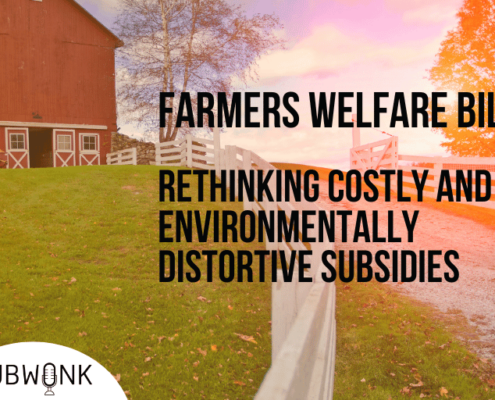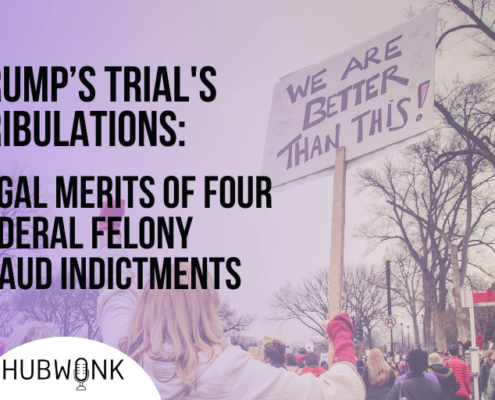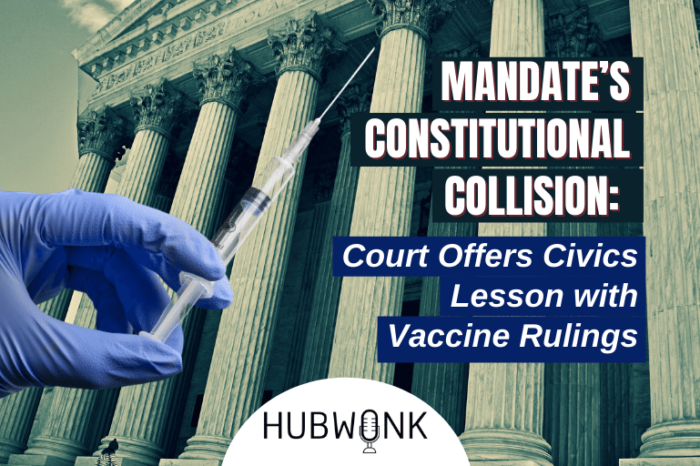Mandate’s Constitutional Collision: Court Offers Civics Lesson with Vaccine Rulings
/in COVID Podcasts, Featured, Podcast Hubwonk, rCOVID /by Editorial Staff
Hubwonk host Joe Selvaggi talks with Cato Institute Vice President Ilya Shapiro about the recent Supreme Court vaccine mandate rulings and what they tell us about the limits of executive branch power and the sitting justices’ views on the guidance of the U.S. Constitution.
Guest:
 Ilya Shapiro is a vice president of the Cato Institute, director of the Robert A. Levy Center for Constitutional Studies, and publisher of the Cato Supreme Court Review. Before joining Cato, he was a special assistant/adviser to the Multi National Force in Iraq on rule of law issues and practiced at Patton Boggs and Cleary Gottlieb. Shapiro is the author of Supreme Disorder: Judicial Nominations and the Politics of America’s Highest Court (2020), coauthor of Religious Liberties for Corporations? Hobby Lobby, the Affordable Care Act, and the Constitution (2014), and editor of 11 volumes of the Cato Supreme Court Review (2008–18). He has contributed to a variety of academic, popular, and professional publications, regularly provides commentary for various media outlets, is a legal consultant to CBS News. He holds an AB from Princeton University, an MSc from the London School of Economics, and a JD from the University of Chicago Law School (where he became a Tony Patiño Fellow).
Ilya Shapiro is a vice president of the Cato Institute, director of the Robert A. Levy Center for Constitutional Studies, and publisher of the Cato Supreme Court Review. Before joining Cato, he was a special assistant/adviser to the Multi National Force in Iraq on rule of law issues and practiced at Patton Boggs and Cleary Gottlieb. Shapiro is the author of Supreme Disorder: Judicial Nominations and the Politics of America’s Highest Court (2020), coauthor of Religious Liberties for Corporations? Hobby Lobby, the Affordable Care Act, and the Constitution (2014), and editor of 11 volumes of the Cato Supreme Court Review (2008–18). He has contributed to a variety of academic, popular, and professional publications, regularly provides commentary for various media outlets, is a legal consultant to CBS News. He holds an AB from Princeton University, an MSc from the London School of Economics, and a JD from the University of Chicago Law School (where he became a Tony Patiño Fellow).
WATCH:
Get new episodes of Hubwonk in your inbox!
Read a Transcript of This Episode
Please excuse typos.
Joe Selvaggi:
This is Hubwonk. I’m Joe Selvaggi.
Joe Selvaggi:
Welcome to Hubwonk, a podcast of Pioneer Institute, a think tank in Boston. Despite the efficacy of COVID 19 vaccines in increasing disease resistance and in reducing incidence of severe symptoms and death, many Americans have decided to decline to be vaccinated as an effort to increase vaccination rates. And in the absence of legislative action from the us Congress, president Biden called for a federal vaccine mandate first for nearly 100 million American workers through the occupational health and safety administration or OSHA, and also through the centers for Medicare Medicaid services or CMS, the resistance to these federal mandates has culminated in legal challenges ending with the Supreme court, determining the OSHA mandate unconstitutional, but also allowing the CMS mandate to take effect. What can these different outcomes of these two cases tell us about repeating powers amongst our branches of government and how does it reveal the different views of the constitution itself held by the justices on the Supreme court? My guest today is Ilya Shapiro, vice president of Cato Institute, director of the Robert A. Levy center for constitutional studies and publisher of the Cato Supreme court review. Mr. Shapiro has written extensively about this Supreme court, including his recent book Supreme disorder, and will share with us his views on the merits of these two cases and what the decisions can tell us about the views of the nine sitting justices. When I return, I’ll be joined by constitutional scholar, Ilya Shapiro,
Joe Selvaggi:
Okay, we’re back. This is Hubwonk. I’m Joe Selvaggi, and I’m now joined by vice president of Cato Institute and constitutional scholar, Ilya Shapiro. Welcome back to Hubwonk, Ilya. Good to be with you. Happy new year. Thank you. All right. We’re gonna be talking about the Supreme court recent rulings on the OSHA and the CMS vaccine mandate it’s about which you’ve written a great deal about these cases. But before we get into constitutional law, I want to offer our, our listeners a little bit of a civics lesson. I think it might arguably be a high school level civics lesson, but I think it’s important for background,about understanding why there might be tension between an executive of branch ruling and the constitution. So let’s start at the beginning. We know that we have a Congress to make laws and we have an executive branch to implement the laws. How do these concepts play out when we’re talking about something like a vaccine mandate?
Ilya Shapiro:
Right. Well, throughout the pandemic, there has obviously been lots of innovative, novel public policies that we haven’t had to contemplate. Most of the action that’s reached the Supreme court, at least until this month has involved states policies with claims based on individual rights. They’re restricting my freedom to get together in a church and, and worship. They’re closing my gun store, you know, hurting my second amendment rights, economic Liberty claims that is different state power. The nature of state power is different from this most recent argument and decision by the Supreme court regarding federal mandates, whether we’re talking about the, the OSHA private sector business mandate or CMS health and human services requirements for workers of facilities that receive federal medical care or Medicaid funds or others that, that have not reached the Supreme court like federal contractors or federal employees, the federal government gets its powers from the constitution, from the us constitution, which enumerates the items that the federal law making authority can affect things like raising armies or coining money or regulating interstate commerce.
Ilya Shapiro:
A lot federal programs are, are based on that ladder state powers on the other hand are kind of background inherent powers of a sovereign what what’s referred to as the police power which doesn’t refer necessarily to the cop on the beat or the the old band featuring sting, but rather a general authority to legislator regulate for the public health safety, welfare, and morals as, as traditionally defined. And so typically with various state regulations during the pandemic the, the claims are not that the state is going beyond its power. Sometimes there are claims under state constitutional law that the governor or health executive is, is overstepping his or her bounds under state law. But it’s general, these are generally claims that, that the, the government is, is violating various kinds of individual rights.
Ilya Shapiro:
And the most important case in the Supreme court that gets talked about a lot in this context is from 1905 during the smallpox epidemic in in, in, in the United States and, and throughout the world, a case called Jacobson versus Massachusetts, where that state required people to get vaccinated or pay a $5 fine, which is about 150 bucks in today’s money and the super Supreme court okayed that. But again, that’s a state mandate. What we’ve been dealing with lately with the, by administration’s federal mandates most notably the OSHA one that affects I think it’s 84 million people. The question is, does the federal government have the power to impose that? And does OSHA as a regulator of, of workplace safety and conditions, does it have the power to promulgate that kind of requirement on employers?
Joe Selvaggi:
So let’s, let’s talk about that. We’ve got an agency, an ex executive agency that has in its name health and say safety. It’s been given the task of keeping workers safe how much latitude is enjoyed by an executive agency. Naturally it’s an agency is created by Congress. It’s given powers by Congress, but how much latitude does it have within those powers?
Ilya Shapiro:
Well, ultimately the Supreme court rule to put kind of the bottom line up the Supreme court ruled. And, and again, this is an emergency procedural case that hasn’t been fully litigated on the merits, but I think the, the writing is on the wall. If it ever returns to the Supreme court what the court majority there was a six to three decision said was that the risk from COVID transmission is not a workplace hazard. It’s a general hazard of life in America, in the world during a pandemic. And so in effect, if OSHA had the power to regulate with respect to COVID require vaccinations, then there’s no limit on what it could do. And at the very least at the very least Congress, would’ve had to specify explicitly that it was giving OSHA the power to impose these kinds of, of mandates.
Ilya Shapiro:
And the only clear statement we have from Congress is a resolution of disapproval by the Senate that was passed in, in December after OSHA promulgated its emergency rule. So you know, this, this is, you know, even if OSHA is constitutional setting aside that kind of deeper constitutional debate about whether regulating workplace conditions is a proper regulation of interstate commerce or things that affect interstate commerce setting that aside the, the, the court found. And I agree with this that, that what OSHA was doing here goes beyond regulating workplace Condit.
Joe Selvaggi:
So I just wanna be clear on this, and again, I don’t wanna split hairs, but these were emergency orders, but in theory, if, if Congress had given them the right to explicitly mandate vaccines, then this would not have been an issue.
Ilya Shapiro:
It would’ve been a different sort of case. So what the Supreme court decided was based on statutory law, that the OSHA has powers to address grave dangers in the workplace when they’re necessary to do so. That’s the emergency standard. And OSHA has a, not a very good track record with these emergency, what are called ETS emergency temporary standards. It has until this one, so this is the 10th time it’s ever implemented in emergency standard of the previous nine, six were challenged in court and only one was fully upheld. So courts have been wary of giving OSHA that kind of emergency standards, maybe if it had put in the rule through a normal process of notice and comment, this now gets into administrative law and something that justice Amy Coney Barrett said during the oral argument that if it had had gone through normal process, maybe there would’ve been more deference out or what have you, but regardless if OSHA was let’s say if, if Congress had given it the power, then there wouldn’t have been that statutory claim that it was going beyond its its authority.
Ilya Shapiro:
Instead it would just be the constitutional argument over whether Congress even has that power to give an executive agency or, or, or whether it’s a violation of what lawyers call the non delegation doctrine that is delegating away law making authority or for that matter a question of whether this kind of regulation would be improper that goes beyond federal authority under the interstate commerce clause.
Joe Selvaggi:
So we’re talking about either going the path of an emergency, which doesn’t have a good record track record in the courts. I, I guess largely based on the fact, it wants to ensure that OSHA and the executive branch don’t have unlimited power unchecked power. If again, I don’t wanna torture this question, but I wanna get to the concept of major questions, which is that if the Congress gives broad let’s say vague authority one can either interpret that as saying it’s inclusive meaning or enumerated, I, I guess, would be the right term or it’s vague enough to allow anything to, to happen. Was that an issue in, in, in this particular case?
Ilya Shapiro:
Absolutely. Several justices during oral argument two Fridays ago now raised the, the major questions doctrine, which, which holds that Congress does not lightly give authority to executive agencies over major questions. What’s a major question, well, something worth you know, significant amount of money or a major change that affects, you know, a lot of people’s lives. There, there are, you know, there have been various there’s precedence about, about, what’s a major question, certainly a vaccination requirement that, that affects, you know, 84 million people qualifies. There’s no debt out about that. And this goes back to what the late justice Scalia, more than 20 years ago, referred to as the principle that colorfully that we don’t hide elephants in mouse holes. That is if you’re going to assert, if an administrative agency is going to assert such sweeping authority, there better be explicit authorization by Congress, you can’t base that, that sweeping authority on vague or ancillary statutory provisions or what the justice Kavanaugh during oral argument called a, a cryptic provision. So it has to be explicit. It has to be clear otherwise courts will not assume that the agency has that kind of power.
Joe Selvaggi:
I see. So in other words you know a vaccine that affects 84 million people is the elephant. We can’t find that in the, in the vagaries of, of, of the OSHA’s charter, I suppose. I wanna go back to a concept you had
Ilya Shapiro:
I’d say both, both in the oral argument and the ultimate opinion, the court left open, the idea that O OSHA could, could regulate more narrowly, let’s say there are workplaces where people have, or closely together, and it can’t be well ventilated or, or, or something like that. You could imagine very targeted sorts of regulation about COVID that are specific to that kind of workplace. I think given the standard that the court, how it wrote its opinion, something like that might pass must, but
Joe Selvaggi:
I wanna get back to an E more fundamental concept. There was a lot of debate about what you referenced earlier is police power. Let’s assume we have a mandate from from OSHA and now it’s out there. How does the federal government enforce such a mandate you know, again, police power reside with the state how does that work?
Ilya Shapiro:
Well, OSHA has health and SP safety inspectors that enforce all sorts of, of regulation. What kinds of protective equipment you have to have if it’s a dangerous workplace the amount of rest that workers have to have truckers say although the department of transportation has a say in that as well. They, they, they love you fines. They, you know, workplaces are, I believe under the new rule are supposed to submit their safety plans, submit their certifications. I, I guess, with this new rule that their, their workforce is vaccinated or is employing the alternative, which is to produce a weekly negative COVID test on the employees dime and time the employer does not have to provide them with that. And so the, the OSHA, you know, bureaucrats will be reviewing those sorts of things.
Ilya Shapiro:
It’s not like instantly when this goes to effect or had it gone into effect. Cuz of course now it’s stayed by the Supreme court that the very next day, anyone who’s in violation will be have a SWAT team sent on them. But it’s, it’s basically the same way that OSHA would, would enforce any other kind of regulation as there are inspectors. There are there’s paperwork to submit that, that, that people then review and that’s that’s how they proceed. And there are fines, I think it’s up to $14,000 a day or per employee. I think that, that I saw it’s a pretty, pretty significant fines for non-compliance.
Joe Selvaggi:
I wanna develop the idea that you talked about C certain aspects X of the mandate are too broad namely that it’s all workplaces. I, I can imagine we would differentiate between meat packing, which seems to be the scenario whereby we, we can imagine it being a useful mandate versus a lifeguard who’s out there on a chair by himself, unlikely to get COVID while at work. That would be an example of perhaps why the they had a problem with how vague it was you know, say more about the way it could have been crafted, perhaps a mandate that could have been crafted that might have got, and the blessing of nine justices,
Ilya Shapiro:
Right there, there are exemptions for purely outdoor workers, although it’s a, it’s very hard to meet that exemption. So you’d think, oh, so lifeguards like, like your example or landscapers or something like that, but it turns out not very many of those qualify based on how the, the state ands are written. And meanwhile not all indoor workers conversely are covered. And for that matter, there’s a relatively arbitrary 100 employee trigger. So if, if your business has 99 employees, you are not subject to this mandate, no matter how cramed in with whatever ventilation there might be that, that you might have, if you’re a hundred or 101 employees, and they’re scattered throughout the country, working remotely in their own homes you are covered. So that sort of arbitrariness and lack of tailoring while imposing this kind of burden, I think is, is something that the court looked at.
Ilya Shapiro:
And they, they did hint the justice. It was relatively sure order opinion cuz they produced it, I think in four or five days after the argument. But they did hint on the sorts of things that if OSHA now, rather than pursuing the litigation, which is ongoing in the lower courts and for that matter I just submitted with a couple of colleagues, a regulatory comment cuz the period only closes tomorrow. You can give comment for OSHA trying to finalize the rule, not to transform it from an emergency to a, to a regular rule. So we just submitted that yesterday, still taking comments, still proceeding with on the understanding that it’s, it’s going, it wants to implement it long term if it abandons that goes back to the well and, and re crafts, the rule such that it covers, you know, certain tight spaces or has exemptions for employees working remotely or, you know, purely out, you know, relaxes the definition of makes it more common sense definition of what working outside means that could indeed survive statutory muster because at that point, OSHA is indeed treating different workplaces is differently in treating unique risks from an infectious disease differently in certain workplaces.
Ilya Shapiro:
The same way that OSHA requires you know protective equipment ventilators, headgear, various kinds masks, and so forth where they’re infectious or other kind of, of, of agents and doesn’t broadly require them for, for every type of, of employer.
Joe Selvaggi:
Does the now we keep referring to this as a vaccine mandate, but it was the vaccine or tests and I guess mask mandate. Does that strengthen the argument? Meaning, look, we’re not forcing you to vaccinate. We are forcing you to either vaccinate or test does that make it more palatable? Let’s say for Supreme court muster,
Ilya Shapiro:
The lower court, the, the sixth circuit had that looked at this before the before the Supreme court did, there was a dissent from judge John Bush who pointed out why it actually is a, a vaccine mandate that the, the alternative is, is sort of EEM ephemeral or so burdensome as to effectively act as, as, as coercion, towards getting people to, to vaccinate in the first place that you have to do it weekly, you have to pay for it yourself. OSHA is not providing that. You have to take own time to do it. And I think there have been quotes from the the secretary of health and human services, Javier president Biden when he announced the mandate back in September before the rule was, was made explicit and put on paper said that we’ve lost our patients. So it’s, it’s clearly all targeted to get people to, to vaccinate the, the, the alternative is not really you know, it’s, it’s, it’s too burdensome. Maybe if it was truly a, a testing alternative such that the government provided the test and they were available at the workplace or, or something like that, maybe it would be evaluated somewhat somewhat differently.
Joe Selvaggi:
It’s perceived to be coercive forcing people to vaccinate, not, not, not having a good faith allowance for those to prefer to test and rather than vaccinate I, I want to move on then to, you know, the, the meat of your expertise in analyzing and understanding of the court and its, and its members. We had a six, three ruling, as you mentioned but it wasn’t just six anonymous judges and justices and three dissenters. There were, as I saw it three rulings, there was the precum, which is the majority, which we don’t know who wrote. Then there were the concurring opinion justices and there was the dissent. Can you break down on the 3, 3, 3 and, and tell us why each decided the way they did?
Ilya Shapiro:
Sure. So the, the pre Curium, as you said, this is when there’s an, an emergency or, or some sort of unusual procedural posture. It’s often that the court decides that it’s not, that they, you know, are ashamed to reveal who wrote it. It’s just kind of the, the process that they, that they generally follow with the, these kinds of procedural postures. But that w was the to, to use the shorthand. It was the six Republican appointed justices of chief justice, Roberts justice, Thomas Alito Kavanaugh Gorsuch, and, and Barrett. And so the three in dissent were, were justices Briar, so and Kagan. And we’ve, we’ve covered the majority opinion. I think, in, in, in, in good depth the concurring opinion, it was written by justice Gorsuch with Thomas and Alito joining made the, went, went more into the major questions doctrine and the, the issue of who decides that it shouldn’t be it should be the people’s representatives.
Ilya Shapiro:
It shouldn’t be judges. It shouldn’t be the, the administrative agencies that, that, that after all were not were not elected. And so that kind of plays to what Gorsuch and other contexts have talked, has talked about the hydraulic pressures on the, the, the checks and balances of our constitutional order and making sure that that there is political accountability. It’s not just an executive agency kind of the fourth branch of government is some of have called it beyond on the original three that we learned about in grade school that that’s taking authority, that it, that it doesn’t have in dissent. It was they, they, they specified briars Kagan did that. They were all three of them were co-authors of it. They talked about the severity of the pandemic that OSHA specifically was regulated danger regulating dangers in the workplace.
Ilya Shapiro:
It wasn’t regulating people going to optional activities like a baseball game, or you know, social get togethers. What have you working is, is very important. Everyone essentially needs to work to be able to, to live. And so it’s within OSHA’s power to, to control that workplace, that that is their, that is their argument. So in reading three, three, I should add Joe maybe comes in more in the, in the companion. I mean you know, there, there could be a reason why Barrett Kavanaugh and and Roberts join the supplemental major questions argument, unlike other cases where the more conservative justices write separately, I don’t think it was that that concurrence was necessarily more, you know, reaching for more. It was kind of just describing more of a, of, of the doctrine, but you see more of a split in the, in the companion case, which we haven’t talked about, but the mandate on healthcare workers in providers that, that receive federal funding, that’s a different type of constitutional and statutory question because it’s the government attaching conditions onto its own funding.
Ilya Shapiro:
It’s not you know, what are the powers of a regulatory agencies so much, and there, that was a five to four decision to allow the mandate to continue with the Roberts and Kavanaugh joining the more liberal justices in the majority. So you saw some, some, some splits there.
Joe Selvaggi:
So I, I wanted get to the CMS case and compare it with this OSHA case, but I, I wanna give proper acknowledgement of the dissent. I, it was in questions the, at judge. So my compared, let’s say a coworker shedding virus with a, you know, a malfunctioning machine shedding sparks. How is it different if I’m, if I can get hurt at work, either from sparks or from virus, why is it different? Again, acknowledging the, the dissent argument. Why is it different if my danger is a virus at work than a you know, a crane falling on my head? Well,
Ilya Shapiro:
One thing is that people have rights and machines don’t. So the court isn’t is, is dealing with some rights balancing as well, but also I think it, it really back to the, the fact that the, the risk of the virus is is global rather than workplace specific. So if you leave the workplace, you’re no longer subject to these sparks. But if you if you leave the workplace, you are subject to the risk of of, of gaining COVID and a vaccine after all is not workplace specific. It’s not that you get a shot every day at your workplace, and then it goes away, or what have you, this is, you can’t undo it. It’s, it’s something that’s that’s with you forever. It’s I guess you could liken it to having to wear a hazmat suit all the long day, even not on the workplace.
Joe Selvaggi:
Okay. Let’s, let’s segue to the, the CMS case, which is fundamentally different, and it came down differently, right? The the Supreme court allowed it to the, the mandate to continue. You, you’re talking about a different OSHA is different. We’re talking about PR private companies and work in those private companies. CMS is a different animal, which they’re talking about their own sort of members. Describe for our listeners, why CMS is different than OSHA. Fundamentally
Ilya Shapiro:
So much that OSHA is, is a different agency than CMS, is that this is not CMS regulating the workplace per se, but and not even, and not even saying that all healthcare providers have to do certain things. It’s saying that anyone who accepts federal Medicare or Medicaid funds has to comply with certain conditions. And when providers sign up for that fund for those funds, they agree it’s part of their contract that OSHA can change the terms for the benefit of public health and safety. There’s disagreement between the justices between the majority and dissent in this case on whether it’s clear that a vaccination mandate can be part of that that the San accuses, the majority of kind of cobbling together disparate provisions that OSHA, that, that CMS has used to ch change funding conditions over the years to justify this novel type of of mandate. But nevertheless, this is a almost a contract case in the sense of you know, changing the terms of a contract, whether that’s allowed based on what you already agreed to, and the strings that attach federal funding that at the end of the day, a, the provider does not have to if doesn’t like doesn’t have to accept that federal funding it’s, it’s, it’s different than, than OSHA regulating every workplace, regardless of a connection to a federal program.
Joe Selvaggi:
So it’s connected to the fact that the federal government funds these organizations and therefore has certain prerogatives I’ll just relate it to as an aside. As my fellow veterans in our audience will know the department of defenses has, it is always ma had, had always made it clear that it was not our prerogative to refuse a vaccine. My personal experiences, I was dropped into all kinds of places around the world. They consistently lost my shot card. So I probably have enough vaccines in me for a small village. But we’re not saying that members of CMS who sort of I guess accept the terms of of federal money they have more prerogatives or rights than a soldier does you know, what constrains, what CMS could do here. Is there anything I know, you know, in the military, there is no constraint. They can take your life, but CMS is a little different animal.
Ilya Shapiro:
Yeah. And, and what you raise is yet another different type of mandate that is the federal government acting as an employer, whether of servicemen or of, you know, federal workers of other kinds you know, someone, a clerk at the IRS say, or, or for that matter, the, the white house council himself. So you know, the, the power of the government as an employer is different than, than when it’s regulating other entities and different again, with contractors, the rules of government contracting and different, again with CMS, where again, it’s the strings attached to funding and, and you’re right. They can’t retroactively add any rules. In fact, in the, in the constitutional challenge to Obamacare 10 years ago we all know about the individual mandate part that, that John Roberts considered to be a exercise of the taxing power. But we forget that the court at the same time, by a seven to two vote invalidated the forced expansion of Medicaid saying that that was coerced, that was adding new conditions. That is, if you want to keep getting Medicaid funds, you have to agree to the Obamacare expansion that was changing the terms of the game after the fact. So there are limits on the types of strings and how they can be added. And when to CMS funding that in fact is one of the disagreements before the, between the majority and the dissent in this case.
Joe Selvaggi:
I don’t know if I can draw this link, but tell me if this, this follows from my reading, it seems to me that the court in its different ruling one OSHA, it, it, it it’s aid the, the mandate in, in CMS. It, it did not, did it point a history, meaning that OCHA really hadn’t had these prerogatives even in emergencies in the past. And so it won’t have it now. And in the past, CMS has had those sort of powers and therefore the court didn’t wanna take them away. Is, is this sort of, from my sort of layman’s view, a validation of more or less a status quo going forward? Well, I
Ilya Shapiro:
Think everyone agrees that vaccine mandate is, is unique and unprecedented at the federal level because pandemics are unprecedented. The last time we had a major one, the federal go, the federal government went so large. This is before the new deal effectively. I mean, there’s some things around polio in the fifties, but a little bit different. And so the, the precedent that we’re talking about is cm, us changing rules on the fly and having more flexibility to do so as you know, developments and, and health and safety progress and, and, and what have you. And so there is that argument between the majority and dissent of whether adding this rule. And this requirement is like some of the additions of requirements in the past, or whether it’s qualitatively different has either it affects so many people or involves injection into the body rather than, you know, wearing some protective gear or, or what have you. That’s certainly one of the places where the battle is joined over this, whereas in the, in the OSHA case it’s not whether, you know, OSHA has ever done anything like this. It’s, you know a debate over whether this is truly a regulation of the workplace or something broader with no limiting principle.
Joe Selvaggi:
I wanna go right into your as we get close to the end of our show into the, your, your, your deep expertise in understanding the members of the court and help us understand why there was a six, three ruling on in favor of staying the mandate and a five, four ruling on allowing a mandate same nine people go there was some shifting going on. What does this tell us about the court’s makeup? And I’ll, I’d also like you to, to sort of address criticisms of the court is perceived, or is partisan in its, in its decision making. What do you say to to explain either that it, you see it as either partisan or that they are ideologically or intellectually consistent through these two rulings?
Ilya Shapiro:
There are D well, first of all, there are different legal issues. And so justices can, can certainly disagree. So the, the difference is that Roberts and Kavanaugh who were in the majority and staying the OSHA mandate were also in the majority in allowing the CMS mandate to, to be enforced Roberts and Kavanaugh tend to be more pragmatic. I think they, they don’t see probably the CMS mandate as, as an expansion of its power or kind of this threatening and unlimited federal or administrative agency power. They see it as more discreet and tied to the particulars of the, the Medicare and Medicaid statutes. I think that’s how you can, you can explain that thing. And in general, you know, the, the, the, the six Republican appointed justices, I think there’s a lot more different among them certainly in, in the outcome and in votes in certain cases, but also how they approach their craft intellectually.
Ilya Shapiro:
The theories they apply, you know, Roberts is minimalist and incrementalist, more pragmatic Kavanaugh while very much skeptical of administrative power. Also doesn’t wanna make waves doesn’t wanna you know, wants to adhere to stare decisis that is sometimes maintaining erroneous precedent, cuz it would be too disruptive to change it. Thomas, on the other hand, a staunch originalist and also doesn’t care much if at all about stare decisis, Alito is kind of more law and order oriented, defers more to law enforcement, certain types types of agencies and, and not others Gorsuch is the most libertarian of the bunch, if you will also natural law. I mean, anyway, we, we can cycle through these things. I, I don’t think any justice left, right? Whoever, whichever president appointed them is acting as a partisan. I think they, they certainly have different ideological views D different ju Prudential methods and modes and, and that affects the outcome in, in different types of cases.
Joe Selvaggi:
So, so accusations that the the court is partisan or driven by policy, you don’t see any sort of sign of that. And frankly, regardless of the party of the administration, they probably would have ruled in the same way if there was a different person in the white house directing OSHA
Ilya Shapiro:
I think that’s right that the, on your latter point, yeah, I think it was the, they were evaluating the policy, not the, not the president who was promulgating it this court, including the most recent nominees voted frequently against Donald Trump, even, even the ones that, that he nominated himself less occurrence of that. I think from the, the justices on the left I had a, an op-ed in USA today. I think it was three years ago when the, when Sheldon white house who continues to Asai the Roberts five now, I guess, would be the six for, for being partisans and for voting in lockstep. And it, it turns out it’s the Ginsburg four, you know, now would be, I guess, the Briar three who are, are much more together, statistically speaking, which again is not to accuse them of being partisans or being you know, result oriented.
Ilya Shapiro:
That’s just the way the, the different methodologies work fundamentally what we face. And this is you, you can apply this, this insight to a, a host of, of debates over the law or the Supreme court or institutions is that you have divergent interpretive theories mapping onto partisan preference at a time when the parties are more ideologically polarized and and sorted than they’ve been since it lasted civil war. So what looks like partisan fights is, is really evidence of a, of a different kind of dynamic that certainly we, it plays itself out. Whenever there’s a Supreme court vacancy
Joe Selvaggi:
Again, now, now we’re wrapping up. I, I want to talk about the scene in your most recent book on the Supreme court where you say effectively when we’re deciding what’s right and wrong, but rather who decides really ought to be Congress that decides, and, and these fights in the court are, are a reflection of broader failures to resolve questions in Congress. But I wanna talk about the executive branch, just last question. The president seemed to have known that the OSHA mandate was likely to be unconstitutional. You may not agree with that, but it seems that they needed to have a quote unquote work around. Is there political incentive to sense have a an executive order knowing full well is likely to be struck down merely to, in a sense score points or give the people what they want. In other words, they, we, we make, we want a king. We don’t wanna, we don’t wanna a Congress is all of this in a sense an act whereby we know we’re not gonna get have success in the course, but it it’s worth it anyway,
Ilya Shapiro:
That that’s kind of a, a cynical take to have. I think there is some of that going on. Same thing with the CDCs eviction moratorium last summer, that the Supreme court blocked that perhaps the president, the administration wants to have these things in place for as long as they can get away with them until the courts block them. I think that’s a de election of duty, a violation of your oath. If you think that it’s, it’s going to be you know, that it’s not, not constitutional, and yet you do it regardless. But it’s, it’s certainly part and parcel of a, of a long time trend. This is, did not originate with, with Joe Biden. Elena Kagan when to, as a professor wrote a, a seminal LAR article more than 20 years ago called presidential administration. And it was really presaging this era of the pen and the phone as was talked about under president Obama or the idea that Congress is gridlocked or dysfunctional.
Ilya Shapiro:
We can, you know, put a pin in whether it is dysfunctional or, or not different dynamics going on there, but regardless, Congress is not acting, it’s not legislating. And therefore the executive has to act to do the people’s business. That’s not the way our system is supposed to function. It’s not, it’s not healthy. But that’s ultimately why a lot of the biggest political controversies in American life are ultimately decided in the core and by the Supreme court because of course Congress, isn’t deciding them and everything’s thrown into the executive and then, then there’s a lawsuit. And and, and the courts have to decide it’s, it’s not a healthy dynamic. But again, it’s not necessarily something that just dropped into us during the pandemic or under, under the current administration.
Joe Selvaggi:
So we started with a civics lesson and we’ve come full circle around to another civics lesson. I, I appreciate your timewith us back on Hubwonk, you are a font of information. And I think our, our listeners learned a lot today.
Ilya Shapiro:
My pleasure take care, Joe,
Joe Selvaggi:
This has been another episode of Hubwonk, a podcast of Pioneer Institute, a think tank in Boston. If you enjoyed today’s episode, there are several ways to support the show. It would be easier for you and better for us. If you subscribe to Hubwonk on your iTunes pod catcher, if you’d like to help make it easier for others to find Hubwonk, it would be great if you offer a five star rating or a favor review, if you have ideas or comments or suggestions about future episode topics, you’re welcome to email me hubwonk@pioneerinstitute.org.
Recent Episodes:

Farmers Welfare Bill: Rethinking Costly and Environmentally Distortive Subsidies

Predatory Tax Ruling: Supreme Court Closes Door on Home Equity Theft

Sweden’s Pandemic Paradigm: Does Trust in Citizenry Save Lives

Breast Cancer Risk: Testing to Tailored Screening, Treatment, and Prevention

Landlord’s Foreseeable Duty: Who Is Liable When Crime Lands on the Doorstep?

Trump’s Trial’s Tribulations: Legal Merits of Four Federal Felony Fraud Indictments

Black Box Budget: Late, Loaded, and Lacking Transparency




